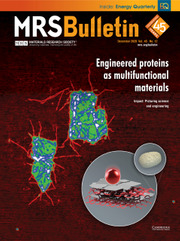Crossref Citations
This article has been cited by the following publications. This list is generated based on data provided by
Crossref.
Chen, Chun-Long
Zhang, Peijun
and
Rosi, Nathaniel L.
2008.
A New Peptide-Based Method for the Design and Synthesis of Nanoparticle Superstructures: Construction of Highly Ordered Gold Nanoparticle Double Helices.
Journal of the American Chemical Society,
Vol. 130,
Issue. 41,
p.
13555.
Gower, Laurie B.
2008.
Biomimetic Model Systems for Investigating the Amorphous Precursor Pathway and Its Role in Biomineralization.
Chemical Reviews,
Vol. 108,
Issue. 11,
p.
4551.
Behrens, Silke S.
2008.
Synthesis of inorganic nanomaterials mediated by protein assemblies.
Journal of Materials Chemistry,
Vol. 18,
Issue. 32,
p.
3788.
Ghiringhelli, Luca M.
Hess, Berk
van der Vegt, Nico F. A.
and
Delle Site, Luigi
2008.
Competing Adsorption between Hydrated Peptides and Water onto Metal Surfaces: From Electronic to Conformational Properties.
Journal of the American Chemical Society,
Vol. 130,
Issue. 40,
p.
13460.
Gebauer, Denis
Verch, Andreas
Börner, Hans G.
and
Cölfen, Helmut
2009.
Influence of Selected Artificial Peptides on Calcium Carbonate Precipitation - A Quantitative Study.
Crystal Growth & Design,
Vol. 9,
Issue. 5,
p.
2398.
Tamerler, Candan
and
Sarikaya, Mehmet
2009.
Molecular biomimetics: nanotechnology and bionanotechnology using genetically engineered peptides.
Philosophical Transactions of the Royal Society A: Mathematical, Physical and Engineering Sciences,
Vol. 367,
Issue. 1894,
p.
1705.
Tamerler, Candan
and
Sarikaya, Mehmet
2009.
Genetically Designed Peptide-Based Molecular Materials.
ACS Nano,
Vol. 3,
Issue. 7,
p.
1606.
Notman, Rebecca
and
Walsh, Tiffany R.
2009.
Molecular Dynamics Studies of the Interactions of Water and Amino Acid Analogues with Quartz Surfaces.
Langmuir,
Vol. 25,
Issue. 3,
p.
1638.
Grosh, Carolynn D.
Schwartz, Daniel T.
and
Baneyx, Francois
2009.
Protein-Based Control of Silver Growth Habit Using Electrochemical Deposition.
Crystal Growth & Design,
Vol. 9,
Issue. 10,
p.
4401.
Skelton, Adam A.
Liang, Taining
and
Walsh, Tiffany R.
2009.
Interplay of Sequence, Conformation, and Binding at the Peptide−Titania Interface as Mediated by Water.
ACS Applied Materials & Interfaces,
Vol. 1,
Issue. 7,
p.
1482.
Wei, Joseph H.
Kacar, Turgay
Tamerler, Candan
Sarikaya, Mehmet
and
Ginger, David S.
2009.
Nanopatterning Peptides as Bifunctional Inks for Templated Assembly.
Small,
Vol. 5,
Issue. 6,
p.
689.
Tamerler, Candan
Khatayevich, Dmitriy
Gungormus, Mustafa
Kacar, Turgay
Oren, E. Emre
Hnilova, Marketa
and
Sarikaya, Mehmet
2010.
Molecular biomimetics: GEPI‐based biological routes to technology.
Peptide Science,
Vol. 94,
Issue. 1,
p.
78.
Monti, S.
and
Walsh, T. R.
2010.
Free Energy Calculations of the Adsorption of Amino Acid Analogues at the Aqueous Titania Interface.
The Journal of Physical Chemistry C,
Vol. 114,
Issue. 50,
p.
22197.
Notman, Rebecca
Oren, E. Emre
Tamerler, Candan
Sarikaya, Mehmet
Samudrala, Ram
and
Walsh, Tiffany R.
2010.
Solution Study of Engineered Quartz Binding Peptides Using Replica Exchange Molecular Dynamics.
Biomacromolecules,
Vol. 11,
Issue. 12,
p.
3266.
Nygren, Patrik
Lundqvist, Martin
Liedberg, Bo
Jonsson, Bengt-Harald
and
Ederth, Thomas
2010.
Secondary Structure in de Novo Designed Peptides Induced by Electrostatic Interaction with a Lipid Bilayer Membrane.
Langmuir,
Vol. 26,
Issue. 9,
p.
6437.
Ikeda, Takeshi
and
Kuroda, Akio
2011.
Why does the silica-binding protein “Si-tag” bind strongly to silica surfaces? Implications of conformational adaptation of the intrinsically disordered polypeptide to solid surfaces.
Colloids and Surfaces B: Biointerfaces,
Vol. 86,
Issue. 2,
p.
359.
Hnilova, M.
Liu, X.
Yuca, E.
Jia, C.
Wilson, B.
Karatas, A. Y.
Gresswell, C.
Ohuchi, F.
Kitamura, K.
and
Tamerler, C.
2012.
Multifunctional Protein-Enabled Patterning on Arrayed Ferroelectric Materials.
ACS Applied Materials & Interfaces,
Vol. 4,
Issue. 4,
p.
1865.
Wright, Louise B.
and
Walsh, Tiffany R.
2012.
First-principles molecular dynamics simulations of ${\rm NH}_4^+$ NH 4+ and CH3COO− adsorption at the aqueous quartz interface.
The Journal of Chemical Physics,
Vol. 137,
Issue. 22,
Donatan, Senem
Sarikaya, Mehmet
Tamerler, Candan
and
Urgen, Mustafa
2012.
Effect of solid surface charge on the binding behaviour of a metal-binding peptide.
Journal of The Royal Society Interface,
Vol. 9,
Issue. 75,
p.
2688.
Wright, Louise B.
Freeman, Colin L.
and
Walsh, Tiffany R.
2013.
Benzene adsorption at the aqueous (0 1 1) α-quartz interface: is surface flexibility important?.
Molecular Simulation,
Vol. 39,
Issue. 13,
p.
1093.




